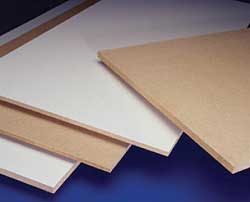Composite Panels: Particleboard and Medium-Density Fiberboard
MDF was developed to help fill the growing need for an economical panel that could easily perform in the same areas as particleboard. The first plant was built in Deposit, NY in 1965. By 1970, production had grown to 215 million square feet (3/4 inch basis). Today, with a U.S. annual capacity of 2.208 billion square feet (3/4 inch basis), it is one of the most rapidly growing composite board products to enter the world market in recent years.
What is Particleboard?
Particleboard consists primarily of cellulosic particles (usually wood) of various sizes that are bonded together with a synthetic resin or binder under heat and pressure. It is used as a substrate for many applications and is available in many different thicknesses and panel sizes. It is also used for case goods, store fixtures, cabinet doors, drawer fronts, wall panels, countertop core, miter folding, ready-to-assemble furniture, shelving, door-core, agricultural box ends, and mobile home decking.
|
Most particleboard manufacturers have created niches in the market that fit their particular abilities. Using different species of raw material and press sizes, some specialize in thin 1/4-inch panels for drawer bottoms and cabinet backs, while others produce 11/16-inch panels for the hardwood plywood industry, 11/8-inch stock for office furniture or 1 1/2-inch panels for door core, or even low-density panels (density is measured in lbs. per cu. ft.).
Typically, particleboard has several layers of different materials-a core and two outside layers, or faces. Face material is fine and uniform-characteristics that lend themselves to laminating and cutting with minimum chip-out. The core is made from coarser and larger particles to reduce the overall density and maintain desired physical and mechanical properties.
A non-structural product, particleboard is generally made from recovered and recycled wood waste. Sources range from post-industrial waste from saw mills, planer mills, plywood plants and so forth, to waste from pallets, construction and demolition sites. Raw materials vary depending upon what is available in the region-Douglas fir and Western Pine in the west, Southern Pine in the south and southeast, and hardwoods in the east and northeast.
Variations in the manufacturing process, such as modifying particle geometry, resin levels, and board density, allow production of panels suitable for a wide range of specific end uses. Incorporating additives during manufacturing provides greater dimensional stability, better fire retardancy, and moisture resistance, as well as additional characteristics.
Particleboard also accepts a variety of overlays, including high-pressure laminate, low-pressure laminate, low basis-weight paper, veneer, vinyl, coatings and decorative metals, making it an even more versatile product.
Because of freight costs, shipping particleboard across the country is generally not desirable, although there are exceptions when certain specifications are not available regionally. Each species has different properties and requires slightly different processing.










